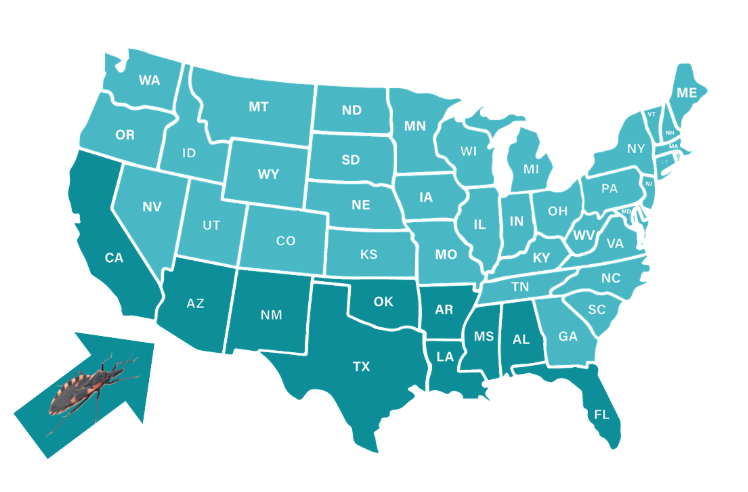
Kissing Bugs:
Cute Name, Serious Risk
Why We’re Talking About Kissing Bugs Now
We don’t usually want to hear the words “kissing” and “bugs” in the same sentence. But here we are, because here they are!
Scientists are now urging US health officials to recognize that Chagas disease, spread by kissing bugs, has quietly become established in parts of the Southern US. That recognition means more attention, funding, and education. Add in warmer weather (which bugs love) and increased travel, and suddenly these late-night biters are part of our national conversation.
So, what are they, why should you care, and how do you keep them from treating your face like a midnight snack?
Meet the “Kissing Bug”
Kissing bug is actually a catchy, common name for several species of triatomine insects. They’re not sweet, they don’t bring you flowers, and they definitely don’t ask for consent. Kissing bugs are night-active blood feeders that often bite around the mouth or eyes, usually while you sleep (that’s how they got their name).
Scientists warn that kissing bugs, once happily at home in Central and South America, have now become endemic in many Southern US states (shaded below), hiding in woodpiles, brush, dog houses, chicken coops, and under porches. Indoors, they prefer cozy cracks, clutter, or your pet’s favorite blanket.

They’re about an inch long and flat, with orange-red stripes on the sides (see image below). They bumble toward porch lights, sneak through cracks, and hide in clutter or pet bedding during the day. If you see one indoors, you’ve got a potentially deadly uninvited guest.
Kissing Confusion
The reason why US health officials want to raise awareness about kissing bugs is because their bites and the disease they carry can easily be confused with other problems. But Chagas disease, left untreated, can be lethal in the long term.
Kissing bug bites can be easily confused with mosquito bites because they cause itchy red bumps on the skin, often in clusters. However, it is not the bite, but rather the parasite the bugs can carry (Trypanosoma cruzi), which causes Chagas disease.

Here’s what happens: After an infected bug bites you, it often leaves microscopic poop at the site. The stool leaves parasites on the skin, which can enter your body through the eyes, mouth, a cut or scratch, or the wound from the bug’s bite. Scratching or rubbing the bite site, which often happens during sleep, helps the parasites enter your body. Once in your body, the parasites multiply and spread.
Here’s the trickiest part: Most people infected with Chagas don’t realize it right away. The disease has three phases, which can look like something else, or nothing at all.
First, if you’ve been infected with Chagas, you may develop fever, some fatigue, and maybe a bit of swelling at the bite site. This could easily be mistaken for “I just need a nap,” or “I think I’m coming down with something.”
Next, once that acute phase resolves, the parasite actually hangs out silently in your body for years, even decades. Scientists call this the “quiet phase,” which becomes the “chronic phase.”
For about one in three people with chronic Chagas disease, the parasite rears its ugly head again in the form of serious heart problems or digestive trouble. Chagas patients may develop heart failure and an enlarged esophagus or an enlarged colon. At that point they have been carrying the disease for decades.
That’s why scientists want to spread the word about kissing bugs and Chagas.
The Good News
There is no question that Chagas disease is bad news. But it is not hard to diagnose, and it is treatable with anti-parasitic medication if you catch it in the acute phase. Chagas can be detected under a microscope with a blood smear or with a PCR test (quite popular during the height of the COVID pandemic).
Blood tests that check for antibodies to the Chagas parasite can detect chronic Chagas disease, but at that point the disease is difficult to treat, and medical professionals have to focus on managing the devastating effects of the disease.
This is why health officials want to raise awareness about the disease and the fact that kissing bugs are no longer only living south of the border. Both providers and patients should be aware of the increased risk of Chagas disease in certain parts of the country.
What You Can Do
If you live in one of the states where kissing bugs have been found, protect your home, yourself, and your pets.
- Seal up cracks, patch screens, and weather-strip doors.
- Store firewood and brush away from the house.
- Swap bright porch lights for motion sensors or warmer bulbs.
- Wear clothing that covers your skin and apply bug spray on skin that’s exposed.
- Avoid eating salads, raw vegetables, unpeeled fruits, and unpasteurized fruit juices if you live in a high-risk area.
- Use bug repellent around home entrances. This works better than using personal insect repellent on your body.
- Keep pet kennels clean and raised.
- Bring pets inside at night when you can.
- Watch for signs like unusual fatigue or fainting.
Pest pros can help if you’re in an area with lots of activity.
The Bottom Line
Kissing bugs aren’t everywhere, but they’re not just a Latin American problem anymore. Knowing how to recognize them, blocking their entry, and acting quickly after a bite puts you ahead of the curve.